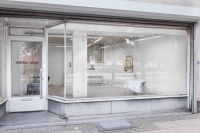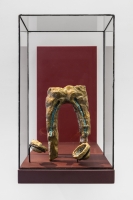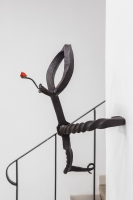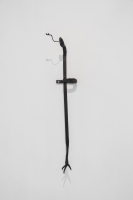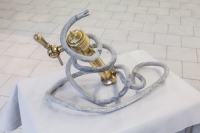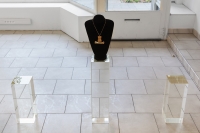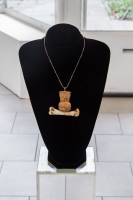EN//
On October 18th, 1988, in Tokyo, German conductor Klaus Tennstedt launched into the final part — Siegfried’s death and Funeral March — from the final act of Richard Wagner’s Götterdämmerung (“Twilight of the Gods”). At 2’12”, for the first time, he breaks the mechanical fluidity of his movements to wipe a tear from his face.
First, he smiles, visibly moved; then, immediately, his eyelid flickers—the typical sign of an imminent tear. Taking advantage of an ample gesture, he passes round his straight lenses (Model-224 Menrad) with his left hand (he is holding his baton in his right hand), a maneuver that strongly emphasizes the dramatic power of the moment.
This is a meticulous gesture, an interruption that brilliantly underlines the narrative.
This is when I ask myself how he managed to cry at work, after rehearsing and performing this work hundreds of times. If this work means performing a representation of emotion (here, mourning), how can this be done sincerely? Or professionally? How to embody this emotion while assessing its effect on the audience so as to avoid distorting the original work?
A nearly political thought in which “naturalness,” “realism,” “sincerity,” “professionalism” would stand in for the nations of an emotional world in permanent conflict.
At the time, I was convinced that this tear reflected the immense sensitivity of a man bound to re-experience the heartbreak, to embody Brunhild’s mourning during each new performance. Convinced that the popularity of such a work would have for a sole consequence the extension of this tragedy and its repetition night after night. I felt increasingly sympathetic for this man in distress.
At 4’30”, Klaus Tennstedt makes the same movement. His gesture is sharper, machine-like: he wants to get rid of this visual hindrance. To turn it into an abstraction. This tear at 4’30” is an embarrassment; the timing is not right; it does not stress anything; narratively out of pace. He does not cry well, he is too hasty; he does not offer anything. He is closing in on himself.
The tear that comes up at 7’56” is more complex than the previous ones. It seems to occur three seconds too early: the final soar has just begun, but the orchestra is still hesitant, febrile, the relation between the conductor and the musicians seems to depend from the tragedy unfolding in front of us. Yet, this tear is perhaps perfectly authentic, for a conductor needs to anticipate his gesture several seconds ahead of the score, and knows what is going to happen next before the audience. It would therefore seem normal that he would be the first to cry. He is the fatally out of step oracle of our aesthetic experience. Thus, he needs to brutally extract himself from our temporality so that our pleasure remains intact. Such is the sacrifice he is displaying, forsaking his professionalism as if to offer us a glimpse outside the scope of his social condition. He is tying us in his place. Meanwhile, Love rises from the ashes of the old world, shattered by deceit and sadness. The ideal moment for a conductor to disappear behind the masterpiece. The slightest improvised gesture would confuse the narrative of this tragic, yet hopeful end. Klaus Tennstedt executes this gesture by running his hand across his face, pointing a finger at his own annoyance.
I wonder, then, if on my deathbed, my last words would be disturbed by an urge to scratch my ear.
As he was aware of being at the center of attention, why couldn't he refrain from interfering? Couldn’t pain caused by sourness from excessive perspiration on a sensitive cornea seem acceptable if we consider the responsibility engaged by this gesture on the respect of the author and of the original work? Rather than respect, he has chosen his own authenticity, the rejection of all sublimation; he has chosen to reveal his weakness, his renunciation in the face of his own pressing impulses, his animality. Klaus Tennstedt had become a beast. 7’57”. I remember David Carradine, the wise, saintly Shaolin monk on screen, found dead at age 72 one morning in Bangkok, holding his genitals, hung in his cupboard, killed while engaging in autoerotic asphyxiation.
At 7’57”, Klaus Tennestedt locked himself up in the same cupboard, his genitals still warm, his own victim, trapped within this cumbersome body.
Benjamin Husson
-----------------------------------------------------
FR//
Le 18 Octobre 1988, à Tokyo, le chef d’orchestre allemand Klaus Tennstedt amorce la dernière partie — Mort de Siegfried et Marche funèbre — du dernier acte du Crépuscule des Dieux (Götterdämmerung) de Richard Wagner.
À 2’12’’, pour la première fois, il interrompt la fluidité mécanique de ses mouvements pour retirer une larme de son visage.
Il esquisse d’abord un sourire ému, puis est directement pris de ce battement de paupière typique annonçant l’imminence du sanglot. Il profite alors d’un geste ample pour contourner le verre droit de ses lunettes (des Menrad modèle 224) avec sa main gauche (il tient sa baguette de la main droite), une acrobatie qui appuie lourdement la puissance dramatique de ce moment. Quelque chose de millimétré, une rupture qui souligne à merveille la narration.
Je me demande alors, comment réussir à pleurer au travail après avoir répété et interprété cette œuvre des centaines de fois? Si ce travail est d'interpréter une représentation de l’émotion (ici un deuil), comment le faire avec sincérité? Ou avec professionnalisme? Comment incarner cette émotion tout en mesurant son impact sur l’auditoire, afin de ne pas dénaturer l’œuvre originale? Une pensée quasi géopolitique dans laquelle « naturel », « réalisme », « sincérité », « professionnalisme », seraient les nations d’un monde-émotion en conflit permanent.
Je n’avais à ce moment aucun doute que cette larme était le reflet de l’immense sensibilité d’un homme, qui revivrait le déchirement, qui incarnerait le deuil de Brünnhilde à chaque nouvelle représentation. Aucun doute quant au fait que la popularité d’une telle œuvre n’aurait comme conséquence que d’étendre ce drame et de le répéter chaque soir. Mon empathie pour cet homme en détresse était grandissante.
À 4’30’’, Klaus Tennstedt réitère ce mouvement. Le geste est plus sec, c’est machinal: Il veut se débarrasser de cet obstacle qui lui trouble la vue. Qui la rend abstraite. Cette larme à 4’30’’ est un embarras, le timing n’est pas bon, elle ne souligne rien, elle est hors de toute narration. Il pleure mal, il pleure vite, il ne nous offre rien. Il se referme.
Celle qui arrive à 7’56’’ est plus complexe que la précédente. Elle semble survenir trois petites secondes trop tôt: la montée finale vient d’être amorcée, mais l’orchestre est encore hésitant, fébrile, la relation entre le chef et les musiciens semble alors dépendante de la tragédie qui se déroule face à nous. Cette larme est pourtant peut-être parfaitement authentique, car un chef d’orchestre anticipe de quelques secondes son geste de la lecture de la partition, il prend conscience avant l’auditoire des événements à venir. Il paraitrait donc normal qu’il pleure le premier. Il est l’oracle irrémédiablement déphasé de notre expérience esthétique. Il doit donc s’extraire violemment de notre temporalité pour que notre plaisir soit entier. C’est ce sacrifice qu’il nous présente maintenant, abandonnant son professionnalisme comme pour nous permettre d’entrevoir le hors-champ de sa condition sociale. Il nous ceinture à sa place. Pendant ce temps, l’Amour renait des cendres de l’ancien monde, dévasté par la tromperie et la tristesse. Le moment idéal que devrait saisir un chef d’orchestre pour disparaitre derrière le chef-d’œuvre. Tout geste improvisé viendrait brouiller le récit de cette fin tragique mais pleine d’espoir. Ce geste, Klaus Tennstedt l’exécute en amenant la main à son visage, pointant du doigt son propre désagrément.
Je me demande alors si sur mon lit de mort, mes dernières paroles seront perturbées par une envie de me gratter l’oreille.
Se sachant l’objet de tous les regards, pourquoi n’a t’il pas résisté à cette intervention? La douleur occasionnée par l’acidité d’une transpiration excessive sur une cornée sensible ne semblerait-elle pas acceptable, si on en juge par la responsabilité que ce geste engage sur le respect de l’auteur et de l’œuvre originale? Plutôt que le respect, il a choisi sa propre authenticité, le rejet de toute sublimation, il a choisi de nous montrer sa faiblesse, son renoncement face à la pression de ses propres pulsions, son animalité. Klaus Tennstedt était devenu une bête. 7’57’’, Je pense à David Carradine, le sage, le saint, le moine Shaolin à l’écran, retrouvé mort à 72 ans, un matin à Bangkok, le sexe entre les mains, pendu dans son placard, victime d’une asphyxie auto-érotique.
À 7’57’’, Klaus Tennstedt s’était enfermé à son tour dans ce placard, son sexe encore tiède entre les mains, victime de lui même, de ce corps encombrant.
Benjamin Husson
-----------------------------------------------------------------------------------------------
Translation: Jean-François Caro
Pictures: Fabrice Schneider
Venue: Château Nour, Superdeals, Brussels
October 2019

